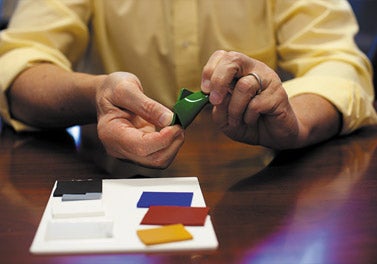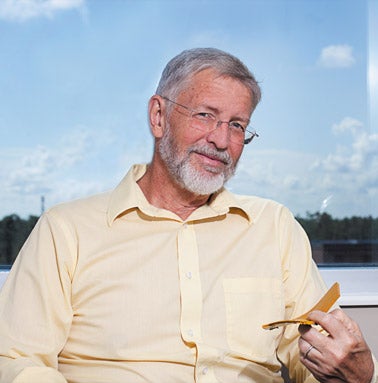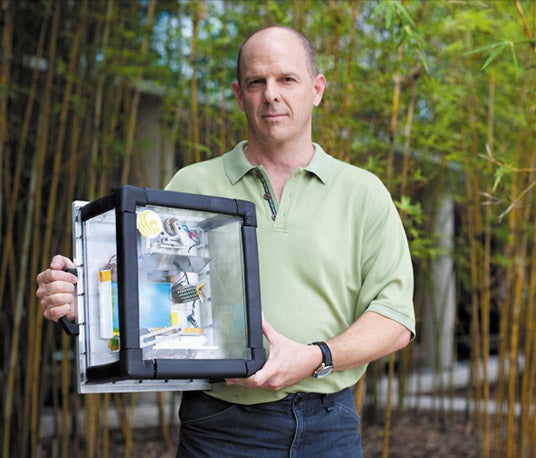Not
Simply
Red
Visual cues help earthling search the alien planet.
In August 2012, NASA’s Curiosity rover landed on Mars, following an eight-month flight and what NASA engineers described as “seven minutes of terror.” The vehicle descended through Mars’ atmosphere, decelerating from 13,000 mph to a dead stop while the mission’s team of engineers were able to do nothing more than look on and hope for the best.
And when the $2.5-billion vehicle landed successfully, UCF was on board.
NASA’s Go-To Guy
“I expected it to work, so I was pretty calm about the whole thing,” says Dr. Daniel Britt, UCF physics professor and inventor of the color calibration targets that reside on the Curiosity rover. “I looked forward to seeing where it would end up and what it would look like … and I wasn’t disappointed.”
Britt’s color calibration products are the key to making the color in the images shot by the Curiosity rover’s cameras precise, balanced and recognizable relative to how we see color on Earth.
“We see color as light going through an oxygen atmosphere at normal temperature and pressure,” Britt explains. “To understand color on another planet—viewing things through an atmosphere with alien temperatures, less pressure, half again as far from the sun—we need a reference, a chip that tells us what blue is, what red is, what green is. When [scientists] take a picture on Mars of the calibration target and then take a picture of something else, they can back out what blue is supposed to look like so it makes sense to us. It’s a color reference chart.”
While his work on Curiosity has captured significant attention, Britt says Mars hasn’t always been his primary focus. “I went to grad school at Brown because I wanted to work on planetary exploration and asteroids,” he says. “Mars is a sideline.”
A sideline, perhaps, but Britt has played an important role in just about all of NASA’s Mars missions over the past 15 years, serving as the project manager for the camera on the Mars Pathfinder, and providing calibration targets on the Spirit and Opportunity rovers, and the Phoenix lander.
Regarding the calibration targets, for which he has become the go-to guy, Britt says simply, “I’ve got the space-qualified design, which has gone through vibration, thermal, vacuum, radiation and UV testing. And once you go through all this, it becomes a half million-dollar project—$10,000 to make the target and a half million for testing. So now it’s cheaper for NASA or the instrument makers to call me and say, ‘Dan, can you make this for us?’”
If It Were Easy, Everybody Would Do It
To become a successful interplanetary scientist, learning to navigate the solar system is only one of the challenges. You must also learn how to navigate the bureaucracy of NASA.
“What is it like working with NASA?” Britt asks rhetorically. “Well, if it were easy, everybody would do it. It has its own frustrations and rewards. But if you’re using public money, that’s just part of the landscape. They’re trying to balance what they think is an interesting planetary program with the money Congress gives them. They are fairly generous, allocating more money than the National Science Foundation, for example. Compared to a lot of space nations, we’re doing okay.”
And what would he want if he made the rules? Britt doesn’t hesitate. “I would like the taxpayers to give me half a billion dollars so I could collect samples from the Martian moons.”
“The moons collect debris, sediment and other particles tossed off by Mars that trace back to the earliest days. The same particles are now buried deep on Mars, but I believe they are retrievable on the surface of the moons.
“We could bring samples back to Earth and analyze them grain by grain to learn, for example, how warm and hospitable Mars may once have been.”
“The moons collect debris, sediment and other particles tossed off by Mars that trace back to the earliest days. The same particles are now buried deep on Mars, but I believe they are retrievable on the surface of the moons.
“We could bring samples back to Earth and analyze them grain by grain to learn, for example, how warm and hospitable Mars may once have been.”
If You Think You’re Right, You’re Probably Wrong
With the success of his work, Britt seems like the right person for young scientists to turn to for career advice. And indeed, his advice is simple.
“If you’re the kind of person who worries about being wrong, you’re in the wrong profession,” he says. “We [planetary scientists] learn new stuff all the time. Reality keeps challenging our assumptions. As an explorer, you’re trying to discover the reality, just like Columbus. He was dead wrong about his assumptions, but he discovered two new continents.”
Being wrong is, in fact, the very thing that motivates Britt to go to work every day. “We thought we knew a whole lot about the solar system 20 years ago,” he says, “but we were wrong. What gets me excited about the work I do in space science is that this is a big solar system, and we’ve only scratched the surface. There’s something new to be learned all the time.” ✦


Dr. Daniel Britt, College of Sciences, holds the materials used for the calibration targets. The materials are extremely stable, flexible and “innocent,” meaning they will not damage tools on the Curiosity rover.
“We see color as light going through an oxygen atmosphere at normal temperature and pressure. To understand color on another planet … we need a reference, a chip that tells us what blue is, what red is, what green is.”
Color Cues
There’s no doubt that Mars is reddish. But with Britt’s color targets, scientists can distinguish between rust and yellowish brown or earth tone. In addition, color images help identify surface compositions.






In the Field of Space Science, UCF is a Shining Star
While the space-related buzz these days revolves around the more than 7,000 shuttle-related jobs eliminated in Central Florida, Britt and his colleague Dr. Joshua Colwell have reason to be optimistic.
Colwell, a professor in the Department of Physics’ Planetary Sciences group and interim assistant director of the Florida Space Institute, says, “Overall, the space program and UCF still have a number of points of intersection. NASA has budgeted $5.4 billion just for science. That’s a significant amount of money for scientific research.”
Britt agrees. “The problem the space industry has is that it’s still very expensive to get into space, and NASA has limited funds. Up to now, a big chunk of NASA was committed to getting humans into space, but today, the science continues on, and UCF is doing pretty well in that.”
Colwell is a member of the science team on the Cassini mission to Saturn, and his experiments have flown on a space shuttle, as well as on suborbital flights, including rockets and parabolic airplanes.
Earlier this year, Dr. Joseph Harrington and doctoral student Kevin Stevenson led a team that detected UCF’s first planet, named UCF-1.01, which is located 33 light-years away.
Dr. Humberto Campins, an international expert on asteroids and comets, is involved in a mission to collect samples from a nearby asteroid. The samples, Campins says, “should be rich in primitive materials, specifically organic molecules and hydrated minerals from the early days of our solar system. If successful, it could give us clues about the birth of water and life in our world.”

Dr. Joshua Colwell, College of Sciences, holds an impact chamber from the Physics of Regolith Impacts in Microgravity Experiment (PRIME), designed for microgravity and reduced gravity parabolic airplane flights. The results help scientists understand the early stages of planet formation, the evolution of Saturn’s rings, and the working environment for astronauts and robots on the surfaces of the moon and asteroids.
Mars Surface and Planet Images Courtesy of NASA/JPL/Caltech